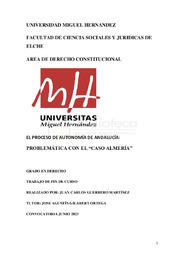Resumen :
Este trabajo trata sobre la evolución y consecución del Estatuto de Autonomía de Andalucía y los problemas que se dieron en la provincia de Almería. Para ello trataremos la evolución histórica de la autonomía en la que hablaremos del llamado "padre de la patria" como fue Blas Infante, la creación de la Constitución Federal de Andalucía de 1883. También veremos como se creó la junta preautonómica que luego se convirtió en la actual "Junta de Andalucía". Me ocuparé del 28 F, fecha en la que se celebró el referéndum en Andalucía, cuyo objetivo era conseguir por fin la autonomía de la comunidad, lo que fue difícil de admitir tras la negativa en la votación, primero en Jaén que se resolvió sin problema y después con Almería y más tarde con Almería que fue más complicado. Como Almería, al no obtener el 50% del sí en sus votaciones provocó que el proceso fuera lento y costoso. Se abrieron 2 vías en el proceso, una es la del art 143 CE y otra vía es la del art 151 CE. La vía del art 144 era más lenta y no permitía obtener el pleno autogobierno y al no obtener el 50% había que esperar un periodo de 5 años para volver a presentarlo.
Por otro lado, el art 151 permitía obtener el pleno autogobierno y era la vía más fácil para obtener la autonomía, , en este caso el PSOE era partidario de esta vía, que era quien lideraba Andalucía en ese momento, UCD partido político contrario prefería la vía más lenta.
Veremos el testimonio del protagonismo de la época en las votaciones para conseguir la autonomía y por utilidad se hará referencia a la reforma del estatuto de 2007.
This work deals with the evolution and achievement of the Statute of Autonomy of Andalusia and the problems that occurred in the province of Amería. For this we will deal with the historical evolution of autonomy which we will talk about the so-called "father of the country" such as Blas Infante, the creation of the Federal Constitution of Andalusia of 1883. We can also see how the pre-autonomic board was created, which later became the current “Junta de Andalucía”. I will deal with 28 F, the date on which the referendum in Andalusia took place, whose objective was finally to achieve the autonomy of the community, which was difficult to admit after the refusal in the vote, first in Jaén that was resolved without problem and later with Almería and later with Almeria which was more complicated. As Almeria, not obtaining 50% of the yes in its votes caused the process to be slow and expensive. 2 avenues were opened in the process, one is that of Article 144 EC and another route is that of Article 151 EC.
The route of art 144 was slower and did not allow to obtain full self-government and not obtaining 50% had to wait a period of 5 years to resubmit it. On the other hand, art 151 allowed to obtain full self-government and was the easiest way to obtain autonomy, , in this case the PSOE was in favor of this route, which was who led Andalusia at that time, UCD opposite political party preferred the slower way.
We will see the testimony of the protagonist of the time in the votes to obtain autonomy and by usefulness reference will be made to the reform of the statute of 2006.
|
 La licencia se describe como: Atribución-NonComercial-NoDerivada 4.0 Internacional.
La licencia se describe como: Atribución-NonComercial-NoDerivada 4.0 Internacional.
.png)
